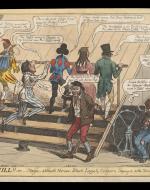Created by Ashley Nadeau on Mon, 08/26/2019 - 18:39
Description:
Although we associate treadmills with fitness and gym culture today, the treadmill was used as a form of punishment in the nineteenth century. Invented in 1818 by William Cubitt (1785-1861), the treadmill was designed as a human powered device for grinding corn, and was not initially intended as a mode of punishment. It did not take long, however, for major prisons to adopt the device as a mode of "hard labor" that would render inmates productive to society. As the British Library explains, "The Society for the Improvement of Prison Discipline considered it a form of 'preventative punishment', reasoning that nobody who had been exposed to it would ever risk reoffending."
This hand-coloured etching, drawn by Isaac Robert Cruikshank and published by John Fairburn, illustrates how the taxing nature of the treadmill might act as a deterrant against future crimes.
Despite its widespread adoption in large prisons, the treadmill was not without its critics. Charles Dickens writes about the treadmill as excessively punitive and torturous in several of his novels. In chapter 13 of Oliver Twist , he writes:
"There was nobody inside but a miserable shoeless criminal, who had been taken up for playing the flute, and who, the offence against society having been clearly proved, had been very properly committed by Mr. Fang to the House of Correction for one month; with the appropriate and amusing remark that since he had so much breath to spare, it would be more wholesomely expended on the treadmill than in a musical instrument. He made no answer: being occupied mentally bewailing the loss of the flute, which had been confiscated for the use of the county..." (93).
Sources:
http://collections.vam.ac.uk/item/O1137445/h-beard-print-collection-print-isaac-robert-cruikshank/
https://www.bl.uk/collection-items/description-of-the-tread-mill
Copyright:
Associated Place(s)
Part of Group:
Featured in Exhibit:
Artist:
- Isaac Robert Cruikshank


